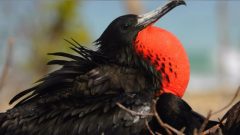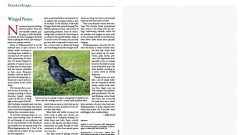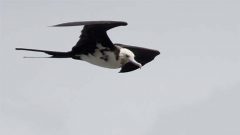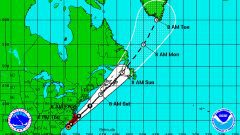Magnificent Frigatebird Similar Species Comparison
Main SpeciesMagnificent Frigatebird
Adult male
An all dark, long-winged, fork-tailed bird of tropical oceans. Males have a bare patch of red skin on the throat (gular sac), barely visible outside the breeding season.
© Marky Mutchler / Macaulay LibraryLouisiana, October 10, 2020Adult female
Soars effortlessly on its long wings using its deeply forked tail to steer. Females have a dark head and white breast patch.
© Daniel Irons / Macaulay LibraryFlorida, February 13, 2020Adult male
Soars across tropical oceans with the occasional slow beat of its wings.
© Timothy Barksdale / Macaulay LibrarySantiago de Cuba, February 01, 2004Immature male (stage 4)
An all dark fork-tailed bird of tropical oceans. Soars effortlessly on its long wings, which have a pronounced bend. Males have a bare patch of red skin on the throat (gular sac), barely visible outside the breeding season.
© Chris Wood / Macaulay LibraryJalisco, February 12, 2004Immature female (Stage 3)
Spends most of its time in the air, gliding for hours with little to no wing movements. Immature females have a white head and belly.
© Bradley Hacker 🦜 / Macaulay LibraryOaxaca, December 20, 2018Adult female
Flies on large angular wings with long tail trialing behind. The tail is deeply forked, but is often held closed.
© DAVID BROWN / Macaulay LibraryBaja California, April 10, 2001Juvenile
Juveniles have a white head and belly.
© Daniel Irons / Macaulay LibraryFlorida, February 13, 2020Juvenile (stage 1)
Juveniles have a white head and belly.
© Jérôme Fischer / Macaulay LibraryManabí, January 26, 2015Adult female
Unlike other seabirds, they lack waterproof feathers and cannot easily take flight from the ground. They typically take flight from an elevated perch that faces into the wind.
© Gregory Griffith / Macaulay LibraryFlorida, May 11, 1994Flock
Flaps with deep wing beats when needed, otherwise soars effortlessly across tropical oceans. Note immatures and females with white heads and breasts.
© David Weber / Macaulay LibraryLa Altagracia, January 09, 2014Similar SpeciesBrown Pelican
Breeding adult (Pacific)
Brown Pelicans are bulkier with much broader wings than Magnificent Frigatebirds, and they lack the frigatebird's long, forked tail. They tend to take more wingbeats and fly lower than frigatebirds, which often soar high in the sky.
© Grace Oliver / Macaulay LibraryWashington, May 17, 2017More to Read
Don't miss a thing! Join our email list
The Cornell Lab will send you updates about birds,
birding, and opportunities to help bird conservation.







